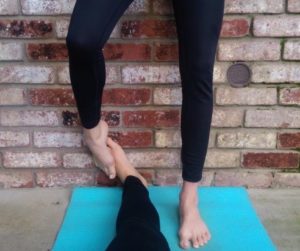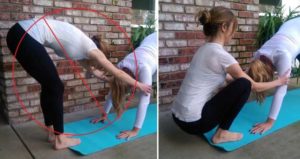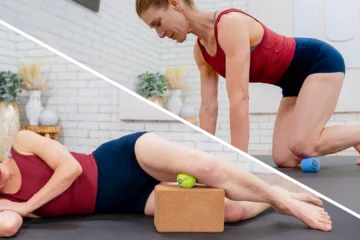
In my last article, I wrote about the importance of being economical with your posture movement at all times. As teachers, our bodies are our paychecks and we should move mindfully at all times. Should you be compelled to make hands on adjustments in class, here are three Yoga Tune Up® based yoganomic components to cultivate your teaching as a means of amplifying your message and practicing sustainability:

- “Be efficient and conserve your energy”
During hands on adjustments, speak your adjustment so the rest of the class can benefit. In Yoga Tune Up® Level 1 Training, we learn how to adjust postures with the feet! If applicable, avoid bending over by using your feet to make adjustments. With some practice, it’s just as effective and could be a back saver.
- “Maintain your spine’s integrity”
No matter what your position during an adjustment, imbue stability with a Yoga Tune Up® technique, Tubular Core. If you don’t know about tubular core, you need to! It’s a way to internally “bubble-wrap” your torso, protecting the spine by keeping your core engaged from every possible angle. Think of pulling your lower ribs in and bracing while you breathe into your rib cage. Not only will this protect your spine, it will also project a non-verbal sense of stability to your clients.

- “Hip Hinge-Come to your student’s level”
Avoid hovering over your students in a dominating fashion. Become more effective by coming down to their level safely without decreasing the adjustment’s potential by utilizing functional squats: Keep your feet hip width or wider, even weight distribution amongst feet, neutral pelvis & spine, shoulders engaged and Tubular Core on.

If squats are problematic for you, train your functional squat with Squat Arms Up with Block at the wall (see picture), a Yoga Tune Up® pose that helps you develop impeccable standards of your spine during your squat. Gradually work your way away from the wall and try different variations with the arms to test your functional squat-abilities.
While these may seem like no-brainers, it is crucial that you embed these techniques into your daily routines and teaching formats in order to enhance your clients experience, practice sustainably and avoid those injuries that may alter or worse, end your teaching career.












Love this article! In Thai Massage, we use techniques that leverage our own bodyweight all the time to conserve energy & be efficient around bodywork.
“As teachers, our bodies are our paychecks and we should move mindfully at all times”..!!! SOOOO true!!! & as we age, we do not bounce back as rapidly as we did in our younger years… The Yogi adage “Health is Wealth” means e-v-e-r-y-t-h-i-n-g to me these days!!! I no longer “muscle through” or push my limits. PLUS it’s so important to model ahimsa with yourself to your students. Thanks for the functional squat training tip… can’t wait to try this at home 🙂
Some great little gems in this article… here are my main take-away points with some of my own feedback.
1) “During hands on adjustments, speak your adjustment so the rest of the class can benefit”… use feet for adjustments where possible – this is totally new to me! Makes total sense since when you are teaching you are giving a lot of energy to not only your whole class, but simultaneously individually to the person you are adjusting.
2) “Maintain your spine’s integrity” – as a 24 year sufferer of chronic spine probleme, this is so key for me, and something I need to not only consider, but apply in any movements I make in my daily life, but especially when you are offering support to another person’s skeletal integrity. “internally bubble-wrap your torso”… “pulling your lower ribs in and bracing while you breathe into your rib cage,” a great cue for tubular core.
3) “coming down to their level safely without decreasing the adjustment’s potential by utilizing functional squats” something I am always working on and realized in my first yoga training, just how important having a stable, low squat form, is. There is a reason I chose Squat Arms Up with Block at the wall as one of my poses to context grids, it is one I want to get to know deeply and intimately, until it is second nature, and my body knows what to do to keep both myself and my students safe and strong during adjustments and hands-on assists.
Thank you for these crucial reminders to practice self preservation while teaching. I especially love the practice of tubular core. For so long I was only focused on activating my lower abs but feeling the entire core has been a game changer!
Great advice and love the word “yoganomics”. YTU practice has made me keely aware of how crappy my posture was and how poorly I bend over. I’ve had to make a conscious effort throughout daily life to use your advice here of “maintaining your spine’s integrity.” It hasn’t been easy to correct lifelong bad habits, but it’s been worth the effort.
Thank you for this! I think many 200-hour yoga-teacher trainings fail to show new teachers how to keep their own bodies safe while doing adjustments — even when safety is encouraged, the actual body mechanics may not be taught. These are great tips — thanks!
Thank you for the helpful tips. I teach yoga to patients in a pain clinic. I teach patients to move safely, but when it comes myself I do not always practice what I preach. Articles like this a great reminders.
I really like appreciate this blog. It is a reminder of the techniques I have learned in Level 1 certification. A great refresher.
It was not until Elizabeth Wipff that I was introduced to the concept of economy of energy in adjustments. Putting verbiage around an idea that is an integral part of crafting a lifelong career was helpful. Thank you for speaking on this topic – our bodies are our passion and our paycheck and we would do well to invest wisely.
I NEED to bring this list with me to classes I’m teaching-” your body is your paycheck”- yes!!! Thanks for the great post:))
I love your ideas, super helpful, thank you!
Tubular Core! TubularCore!! I couldn’t agree more. It wasn’t until TTY with YTU that I realized I myself didn’t engage tubular very well in my own practice!! I also love the adjustments with feet and showing students, alot of students are visual learners that like to see to know. Safety in part for us teachers is def being sure we protect our backs in assist so coming down to the student level will deem appropriate. I used squat with block in my context grid recently and really love how spine lengthening comes into play. It feels fabulous and works you!!
Thank you for sharing!
Thanks for the post. I am now encouraged to work harder on my squat. I learned the Squat Arm Up with Block at Wall today in my YTU training and that was wonderful. Now I just have to practice and get it right!
The squat to the wall with block over head is brilliant.you could also use a dowel to widen your grip.the wall gives you feedback to how your shoulders and back are aligned with arms overhead.i practised some adjustments on my son last night and caught myself in a hovering position, it did not feel good and I corrected myself.adjustments are a symbiotic experience for the practitioner and the student.
Tubular core! It is so important to maintain the tubular core when we practice and teach! I do hover from time to time when I adjust students, and sometimes my low back hurt after. I will practice squat with arms up to build better squat that make my teaching more sustainable. And I really like the option of adjusting using the feet, I will explore this area…Thanks for sharing!
Great reminder. We can’t help care for others unless we take care of our selves first. As a yoga teacher when I started offering hands in adjustments I definitely overextended myself wanting to offer as much as I could. I would totally feel depleted after class. I have learned to pull it back and keep in mind self care first.
I really appreciate this article. I have stayed away from adjusting my student too much since I carry a lot of pain in my body. This article and the techniques I learned in Level 1 certification are truly helping me strengthen my body. I am growing to love the wall squat, I know it will allow for much better adjustments in my students and a stronger body for me.
I love my job as a full time yoga teacher. Thanks and I will definitely try your great tips and techniques about adjusting efficiently and practicing sustainability . I will keep reminding myself. Thanks for your insight!
Great tips on how to be mindful while giving adjustments. I especially appreciate the tips on squatting. I recently read “Move your DNA,” and I realized that I need to incorporate this functional movement into my daily life more. I bought a squatty potty, but that really only gets me in a squat once/day. 😉 Squatting during adjustments is beneficial for the student and for me!
Thanks for the helpful article. Using the feet is a solid tip and so is functional squatting. The other great thing about squatting to give an adjustment is that it’s a great workout for the person assisting. One thing I’ve seen a lot are people who assist so much and put so much energy into it that they have no energy left for their own yoga practice. So, kudos for the article and raising awareness.
I tend to forget to speak to the entire class when I am helping an individual adjust their body, what a good reminder! I aslo struggle with the blood rush to the head when bending over to assist students. It will be work to change these habits but you are correct in them being crucial alterations to how I teach. Thank you for the motivation.
Thanks for the great reminder! I learned the hard way as a young teacher that I needed to be VERY mindful of how I carry myself and assist in classes. I’m pregnant now, and have to be extra careful. I love the idea of using feet and being conscious of conserving energy as much as we can. Thanks for the post!
Thanks for the reminder that it is important to take care of your body when you teach as well as model the way you want your student to move. I was taught by my first yoga teacher not to put your feet on your students so this is something new for me to try. I also try to be aware that some students don’t want to be touched so I ask permission when it is appropriate. Great information!
This article is SO important for teachers who are working full time or even part time but do so much hands on work. I forget how important it is to protect OUR bodies when working on other bodies and how to stabilize the body while doing so. It is a great reminder that when we work we must be efficient with every move and how much energy it yields to produce results. Thank you for showing us proper techniques and cleaner ways of getting in and out of positions safely!
Conserving energy and using good body mechanics to assist students allows us as teachers to spend energy elsewhere whether that’s demo-ing postures, discovering new cue-ing language, or being creative in the moment.
Great advice, when focusing on alignment and adjusting another I often don’t keep any focus on my own alignment not setting a healthy example or feeling as great as I generally do after a delicious class.
Truth! I don’t give physical adjustments often as I try to adjust verbally most of the time. However, I have bouts of physical adjustment teaching and it is important for me to keep this advice in mind to protect my body. I really like the idea of adjusting with the feet as much as possible. Thanks!
Thanks for the reminder. I love giving adjustments because I love receiving them. But I have to be very mindful of the position of my body. I have found myself in unsafe positions more often than I want.
Thanks for the great tips! Especially the one about using more of our feet to adjust–clever! I also love the pose with the block against the wall to build better posture. Love your practical advice!
I agree with getting right where your client can relate with you. Getting down to their level and giving cues that they understand and others can hear is how you motivate and encourage for each person to improve body awareness. Thanks for reminders of taking care of our own bodies.
Great hints – I especially appreciate the one about speaking any adjustment given in class aloud so others can benefit. I’ll be reminding myself of this technique as I teach and thanking you for the prompt! Good work.